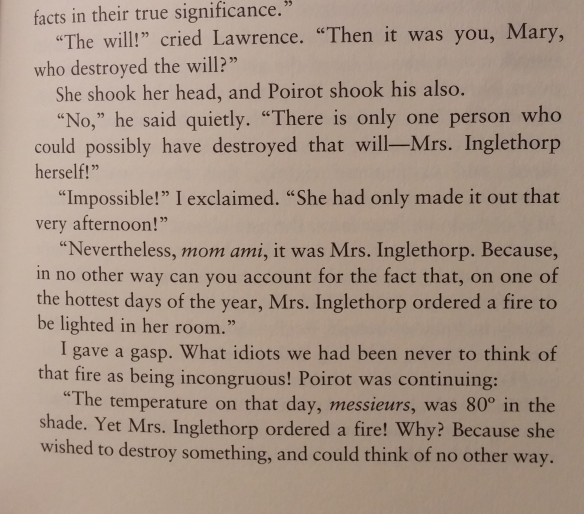Nothing annoys like repetition. “Mom, can I have a cookie?” “No.” “Can I have a chocolate chip cookie?” “Not until supper’s done.” “Can I have a cookie now?” “I said no.” (pause for approximately twenty seconds) “Can I have a cookie now?” (exasperated scream and toss of graham crackers) “Oooh, crackers.” (munching) “Can I have a cookie?” (head bangs wall)
I feel the same way when I read repetition–not just in my students’ essays, but in novels by those who should know better. The characters in Hercule Poirot’s Christmas had some very annoying spells of repetition that revealed no inconsistencies in circumstances or any sort of human nature. They were just part of the interrogation. Other lines had equally annoying bouts of foreshadowing directed at…nothing.
“He’s like the faithful old retainers of fiction. I believe he’d lie himself blue in the face if it was necessary to protect one of the family!”
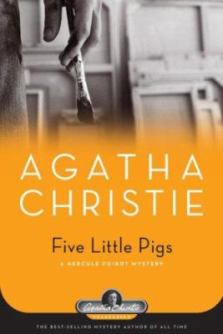 I wanted to believe Christie was better than that with her dialogue. I wanted to see some proof. So I took a risk and picked a story I knew would be more dialogue than anything: Five Little Pigs. It’s a cold-case situation: a young woman comes to Poirot asking him to discover the truth about her parents. Everyone says her mother poisoned her father; the mother was tried and executed for it. Yet her mother’s last letter claims innocence. The daughter, now fully grown, wants to know the truth.
I wanted to believe Christie was better than that with her dialogue. I wanted to see some proof. So I took a risk and picked a story I knew would be more dialogue than anything: Five Little Pigs. It’s a cold-case situation: a young woman comes to Poirot asking him to discover the truth about her parents. Everyone says her mother poisoned her father; the mother was tried and executed for it. Yet her mother’s last letter claims innocence. The daughter, now fully grown, wants to know the truth.
The truth must be found in the memories of others, and to get those memories Poirot must dig through dialogue.
There is nothing so dangerous for anyone who has something to hide as conversation!
–Hercule Poirot, The A.B.C. Murders
Poirot speaks with a few legal members involved with the court case, and then five other people present in the home at the time of the murder. This comes to nearly 240 pages of conversation.
And none of it felt dull, let alone repetitive.
Clearly, Christie’s attentions were more focused on this story. One can feel it in the tight prose and pacing. Her descriptions of the characters are brilliantly precise:
Philip Blake was recognizably like the description given him by Depleach–a prosperous, shrewd, jovial-looking man–slightly running to fat. (58)
[Poirot] would never have recognized [Elsa] from the picture Meredith Blake had shown him. That had been, above all, a picture of youth, a picture of vitality. Here there was no youth–there might never have been youth. (104)
The dialogue also reveals a lot about the characters, such as the governess.
“Men–” said Miss Williams, and stopped. As a rich property owner says, “Bolsheviks,” as an earnest Communist says, “Capitalists,” as a good housewife says, “Black beetles,” so did Miss Williams say, “Men.” (117)
Besides the court personnel, who only witnessed the characters after the murder, there are five perspectives being tapped for details from the same time frame. This should welcome lots of repetition, considering these people are coming to the same house, dining together, conversing together, and so on.
Yet the repetition doesn’t happen. I’ll use one moment in the plot for an example.
Painter Amyas has brought his model Elsa to live at the house while he paints her. His wife Caroline does not like her; it goes without saying Elsa and Amyas are having an affair, which is normal behavior for Amyas and his models. Something seems different this time, though, and Amyas’ friends, the brothers Philip and Meredith Blake, warn him as such. Amyas shrugs them off. Caroline’s teenage sister Angela also lives at the house under the care of the governess Miss Williams.
What follows are four accounts of the same moment in the book: when Elsa announces to all she’s going to marry Amyas…despite Amyas still being married to Caroline. The police officer shares bits and pieces of Philip Blake’s account, so for the sake of sticking with points of view present at the situation, I’ll keep him out.
Philip Blake (considering the length, I felt photos the easiest way to share):

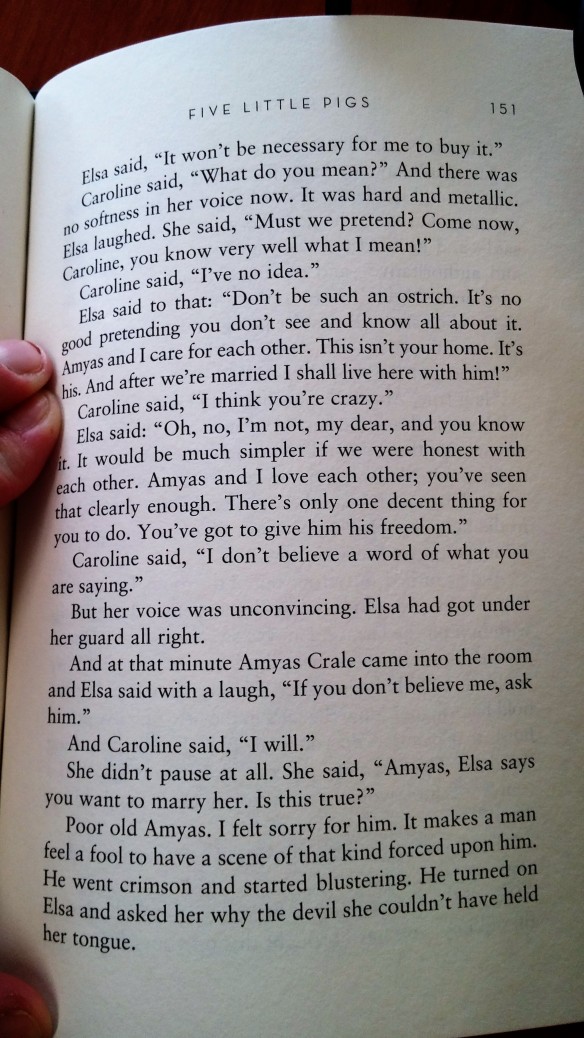
Elsa: And in the end I broke down. Caroline had been talking of some plan she and Amyas were going to carry out next autumn. She talked about it quite confidently. And I suddenly felt it was too abominable what we were doing–letting her go on like this–and perhaps, too, I was angry, because she was really being very pleasant to me in a clever sort of way that one couldn’t take hold of. And so I came out with the truth. In a way, I still think I was right. Though, of course, I wouldn’t have done it if I’d had the faintest idea what was to come of it. The clash came right away. Amyas was furious with me for telling Caroline, but he had to admit that what I had said was true. (183-4)
Miss Williams: On this day, September 17th, as we were sitting in the drawing room after lunch, [Elsa] came out with an amazing remark as to how she was going to redecorate the room when she was living at Alderbury. Naturally, [Caroline] couldn’t let that pass. She challenged her and [Elsa] had the impudence to say, before us all, that she was going to marry [Amyas]. She actually talked about marrying a married man–and she said it to his wife! .. [Amyas] came in just then and she immediately demanded confirmation from him. He was not, unnaturally, annoyed with [elsa] for her unconsidered forcing of the situation. Apart from anything else, it made him appear at a disadvantage, and men do not like appearing at a disadvantage. It upsets their vanity. He stood there, a great giant of a man, looking as sheepish and foolish as a naughty schoolboy. It was his wife who carried off the honors of the situation. He had to mutter foolishly that it was true, but that he hadn’t meant her to learn it like this. (194-5)
Angela: The very first intimation I had of the whole thing was what I overheard from the terrace where I had escaped after lunch one day. Elsa said she was going to marry Amyas! It struck me as just ridiculous. I remember tackling Amyas about it. In the garden at Handcross it was. I said to him: “Why does Elsa say she’s going to marry you? She couldn’t. People can’t have two wives–it’s bigamy and they go to prison.” Amyas got very angry and said, “How the devil did you hear that?” I said I’d heard it through the library window. He was angrier than ever then and said it was high time I went to school and got out of the habit of eavesdropping….I stammered out angrily that I hadn’t been listening–and, anyhow, I said, why did Elsa say a silly thing like that? Amyas said it was just a joke. (199-200)
Notice the extensive detail Philip provides as opposed to, say, Miss Williams. Philip’s bias against Caroline and for Amyas highlights special touches of tension in his telling: “Elsa had got under her guard all right.” “Poor old Amyas…he went crimson and started blustering.” Then you have Miss Williams noting how Caroline “did not lose her dignity,” and later “walked like an empress” from the scene (193). Elsa’s telling revolves primarily around her feelings more than anything else, and Angela’s gets into something new: that Amyas said it was all a joke.
Sure didn’t sound like a joke in that room.
One moment, told again and again, yet with new language and observations every time. This layering through multiple viewpoints gives readers the pleasure of digging for the unknown information and hidden emotions not known from the police account. Christie takes great care pacing out these plot reveals, too–Angela’s account, for example, isn’t given until the second to last chapter of the book.
The key here is that the information differs with each account: there’s always something new to learn. Even the lack of telling can be telling. Notice how Elsa breezes over this moment? You’d think she’d want to rub in how Caroline reacted to being told her husband was leaving her. Yeah, there’s a reason Elsa doesn’t share too much.
(Dunh dunh DUUUUUUUNH)
Now I get that this style of multiple points of view will not fit many kinds of story, nor can every story be told in a series of conversations. But if I’ve learned anything from my own point of view experiment, it’s that one’s got to try different styles of storytelling. Even if what you create isn’t fit for human eyes, you still stretched your brain. All those story-starts I did with Dorjan are going to remain stopped. They’re not going anywhere. But in writing them I did get to thinking about that character’s life, and other pieces that may be worth telling. And then, I got to thinking about other characters from the story and their lives…it goes on.
We don’t always find the right voice for a story in the first go. It might require a process of elimination to discover the true narrator. Or, maybe you’d rather have the different perspectives tell the story together. After all, Christie took a bunch of conversations and wove them into a taut mystery readers couldn’t leave alone. Just imagine what that kind of layering could do for your own fiction.
PS: In the spirit of Sarah J. Higbee’s weekly book cover studies, I wanted to share some of these designs for Five Little Pigs. Frankly, I feel gripped by none of them: not the childish ones, certainly not the giant pig. The one with the flowers is way too busy, and the beer glass of all things emphasizes THE biggest clue in the mystery. I see why later covers tended to focus more on the painting, as it is the catalyst for the murder.







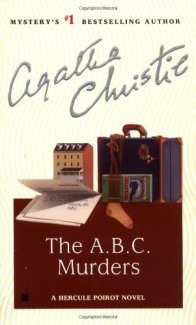
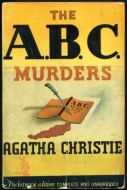 You got your railway guide. Important, but not a giveaway.
You got your railway guide. Important, but not a giveaway. You got the killer’s shadow and A.B.C. Neither are giveaways.
You got the killer’s shadow and A.B.C. Neither are giveaways.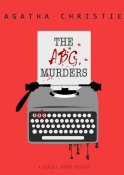 Typewriter: Ibid.
Typewriter: Ibid.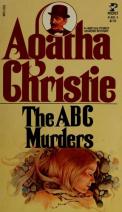 Corpse: Ditto Ibid. Etc. Etc. Etc.
Corpse: Ditto Ibid. Etc. Etc. Etc.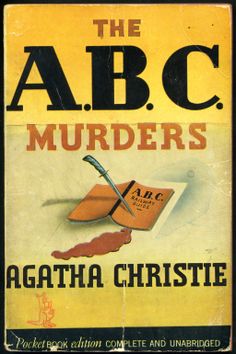 When we think “cozy mystery,” we think of a manor, or someplace isolated, with a limited cast and one, maybe two murders in a tight amount of time. Subtle clues that we didn’t understand come to light when the detective gives his Great Reveal in Act III. My study of The Mysterious Affair at Styles fulfilled such requirements, as do other major
When we think “cozy mystery,” we think of a manor, or someplace isolated, with a limited cast and one, maybe two murders in a tight amount of time. Subtle clues that we didn’t understand come to light when the detective gives his Great Reveal in Act III. My study of The Mysterious Affair at Styles fulfilled such requirements, as do other major 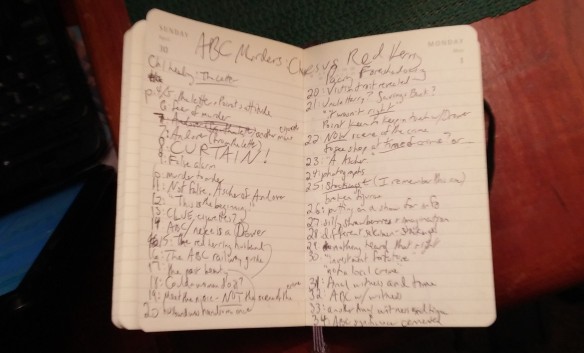
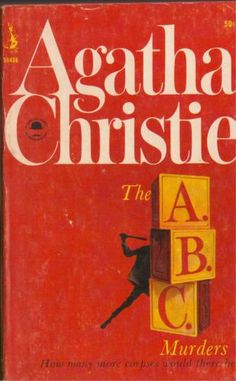 tidbit in. Maybe she counted, maybe not. But I could certainly see why The New York Times said that this book is “The very best thing Agatha Christie has done”–at least that’s what it says on my edition, a 17th printing (SEVENTEENTH!) from 1967.
tidbit in. Maybe she counted, maybe not. But I could certainly see why The New York Times said that this book is “The very best thing Agatha Christie has done”–at least that’s what it says on my edition, a 17th printing (SEVENTEENTH!) from 1967. I admit that I still confuse “unlikeable” with “unreliable” every now and again. An “unlikeable” narrator is not so much a twit as an asshole. One we just can’t bring ourselves to care about. If the story swallows him up, good riddance. If he gets away with it, then we enjoy imagining how he’ll get his comeuppance in the unwritten pages thereafter.
I admit that I still confuse “unlikeable” with “unreliable” every now and again. An “unlikeable” narrator is not so much a twit as an asshole. One we just can’t bring ourselves to care about. If the story swallows him up, good riddance. If he gets away with it, then we enjoy imagining how he’ll get his comeuppance in the unwritten pages thereafter.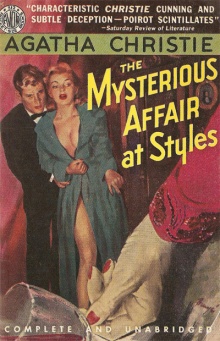 Agatha Christie’s creation of Hastings is,
Agatha Christie’s creation of Hastings is, 
